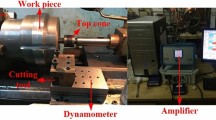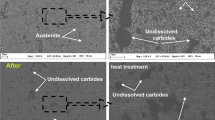Abstract
Broaching fir-slots on the turbine discs is regarded as one of the key processes and the most difficult machining operations due to complex geometry and very tight tolerances. The heat-resistant steel X12CrMoWVNb N-10-1-1 is widely used as material in power-generation turbines. However, the manufacturability of the heat-resistant steel poses enormous challenges to the turbine plants. Subjected to several constraints including broaching force, broaching surface quality and broaching tool’s structure strength, machining efficiency, broaching tool’s life, and so on; the broaching process is mainly influenced by cutting speed, rake angle, clearance angle, and rise per tooth (RPT) of broach tool. A flexible evaluation method for multiple constraints, CRSMMC, is presented to acquire optimization parameters of broach tool for machining heat-resistant steel. Rake angle, clearance angle and rise per tooth (RPT) are designed as three factors by using the central composite design (CCD) method. In addition, broaching experiments of heat-resistant steel X12CrMoWVNb N-10-1-1 were performed in order to set up the model. In addition, the influences of broaches parameters on constraints were studied. The results indicated that the rise per tooth (RPT) was the dominant factor under the constraints of surface roughness and cutting force. Moreover, the predicted values obtained by CRSMMC were in good agreement with the experimental values, which indicated that CRSMMC was an effective method for broach tool’s parameters optimization in broaching of heat-resistant steel X12CrMoWVNb N-10-1-1.
Similar content being viewed by others
References
Wei Y, Wei W, Shan YY, Yang K (2013) Microstructural stability of 9–12%Cr ferrite/martensite heat-resistant steels. Front Mater Sci 7(1):1–27
Liu F, Fors DH, Golpayegani A, Andrén HO, Wahnström GR (2012) Effect of boron on carbide coarsening at 873 K (600°C) in 9–12% chromium steels. Metall Mater Trans A 43(11):4053–4062
Hofer P, Cerjak H, Warbichler P (1998) Quantitative evaluation of precipitates in the martensitic cast steel G-X12CrMoWVNbN10-1-1. In: Lecomte-Beckers J, Schubert F, Ennis PJ (eds.) 6th Liège-Conference Materials for Advanced Power Engineering, Part I, pp 549–557
Liang XG, Yao ZQ, Luo L, Hu J (2013) An improved numerical integration method for predicting milling stability with varying time delay. Int J Adv Manuf Technol 68(9–12):1967–1976
Shao H, Liu L, Qu HL (2007) Machinability study on 3%Co–12%Cr stainless steel in milling. Wear 263(1–6):736–744
López de Lacalle LN, Sánchez JA, Lamikiz A, Celaya A (2004) Plasma assisted milling of heat-resistant superalloys. J Manuf Sci Eng 126(2):274–285
Klocke F, Veselovac D, Gierlings S, Tamayo LE (2012) Development of process monitoring strategies in broaching of nickel–based alloys. Mech Ind 13:3–9
Shi D, Axinte DA, Gindy NN (2007) Development of an online machining process monitoring system: a case study of the broaching process. Int J Adv Manuf Technol 34(1–2):34–46
Kishawy HA, Hosseini A, Moetakef-Imani B, Astakhov VP (2012) An energy based analysis of broaching operation: Cutting forces and resultant surface integrity. CIRP Ann Manuf Technol 61:107–110
Tang YJ, Wang YY, Ji SM, Zhang X, Wen DH (2011) Experimental investigation on the dynamic cutting forces in internal broaching. Adv Mater Res 215:234–238
Sutherland JW, Salisbury EJ, Hoge FW (1997) A model for the cutting force system in the gear broaching process. Int J Mach Tools Manuf 37(10):1409–1421
Jadhav SA, Jadhav VS (2012) Parametric variation stress analysis of keyway broach tool. Int J Eng Technol 4(4):200–207
Özelkan EC, Öztürk Ö, Budak E (2011) Identifying parameters of a Broaching design using non-linear optimization. Int J Model Identif Control 12(3):244–252
Mo SP, Axinte DA, Hyde TH, Gindy NNZ (2005) An example of selection of the cutting conditions in broaching of heat-resistant alloys based on cutting forces, surface roughness and tool wear. J Mater Process Technol 160(3):382–389
Asiltürk İ, Neşeli S (2012) Multi response optimisation of CNC turning parameters via Taguchi method-based response surface analysis. Measurement 45(4):785–794
Liu ZQ, Xu JY, Han S, Chen M (2013) A coupling method of response surfaces (CRSM) for cutting parameters optimization in machining titanium alloy under minimum quantity lubrication (MQL) condition. Int J Precis Eng Manuf 14(5):693–702
Liu ZQ, Cai XJ, Han S, Chen M, An QL (2011) Parameters optimization of turning free cutting steel based on the coupling method of response surfaces. Adv Mater Res 188:301–306
Kokturk U, Budak E (2004). Optimization of Broaching Tool Geometry, Proceedings of 4th CIRP International Seminar on Intelligent Computation in Manufacturing Engineering, Sorrento, Italy, 30 June −2 July, 393–398
Author information
Authors and Affiliations
Corresponding author
Rights and permissions
About this article
Cite this article
Liu, Z., Wang, C., Chen, M. et al. A Coupling Response Surfaces Methodology of Multiple Constraints (CRSMMC) for parameters optimization of broach tool in broaching of heat-resistant steel X12CrMoWVNb N-10-1-1. Int J Adv Manuf Technol 74, 1719–1732 (2014). https://doi.org/10.1007/s00170-014-6109-8
Received:
Accepted:
Published:
Issue Date:
DOI: https://doi.org/10.1007/s00170-014-6109-8




